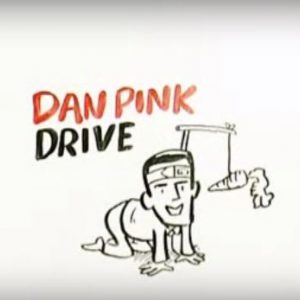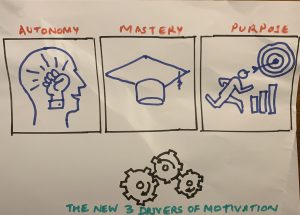If money doesn’t DRIVE people, what does?!
Post by Prasad Narasimhan, Managing Partner based in Bangalore.
What really drives and motivates people? We discussed this fascinating question last week at our brandgym global partner retreat. Each of the six partners read a book related to behavioural economics and we then chatted about the findings over breakfast. In my case, the book was Drive: The Surprising Truth About What Motivates Us by Daniel Pink (1).
The findings are indeed surprising, as I outline below.
Money is only motivating for simple tasks
For simple, repetitive tasks, conventional ‘carrot & stick’ financial rewards do work; Daniel calls these ‘If then rewards’ (If you do this then you get that).

However, for work requiring cognitive or creative ability, financial incentives have a bizarre effect. Research experiments show that people offered the highest level of financial incentive performed worse than those offered a medium or lower level of financial incentive. Money, it seems is not the main motivator and can even have unintended negative outcomes.
An important side-note Daniel makes here is that you need to offer people “enough money for it to not be an issue”. In other words, you need to pay people a decent level of salary compared to the market norm. But beyond this, offering financial incentives to encourage higher levels of performance is unlikely to be effective.
So, if financial bonuses are not the way to drive performance, what are?
The 3 drivers of motivation
Daniel proposes that there are three drivers of motivation in the emerging world of work (see below).
I look at each of these three drivers below, brought to life with some of my own experience.

1. Autonomy
Autonomy is the ability of people to self-direct their work, and hence their destiny.
Personally, I feel I hit “the autonomy jackpot” when I joined the brandgym eight years ago! Each partner shares a common set of values, a clear purpose (discussed below) and a set of tools and techniques captured in our series of brandgym books. But beyond this, each partner has total freedom to design and deliver projects how and when they want.
This level of autonomy may be hard to replicate exactly in the corporate world. But Daniel gives examples of how you can at least inject autonomy into a more structured environment. One Australian software company has a quarterly day when employees are free to work on what they want, how they want and with the team they want. The only requirement is to share the results the day after in a fun session with beer and cake! This approach has created a series of improvements to products and processes.
Action: how can you give people more chances to work autonomously without supervision?
2. Mastery
Mastery is the opportunity to get better & better at what matters to you as an individual. Daniel uses the example of learning to play an instrument to illustrate the power of this driver. Many people spend hours practising an instrument (the flute in my case) for no money. What drives people is the desire to improve and learn.
In our case at the brandgym, all the partners are dedicated to keep work on personal mastery, even though we have each been working in marketing for over 25 years. Focusing on three key services (brand vision, growing the core and brand-led innovation) helps us concentrate on being master of a few trades, rather than being average in many.
We use our global partner retreats to share best practice and learn from one another. We also have an external trainer come in to help us sharpen our facilitation skills. Quarterly online video calls keep the mastery discussion going throughout the year. On every project, I seek to design a brand journey inspired by these best-in-class ideas, such as
- Creating fresher insights to open newer & larger opportunities.
- Inspiring teams with best-in-class examples from across the world.
- Creating and bringing to life bolder brand visions
Action: how much opportunity are you giving people to work on mastering the skills that matter to them, via training courses and also on-the-job practice?
3. Purpose
The final driver is having a clear sense of purpose. This is about having a purpose for your organisation. However, even the best purpose can’t motivate all employees equally. The trick is to also help people visualize their own personal purpose and how this can “sync” with the brand’s purpose.
In the case of the brandgym, we’re all dedicated to helping people achieve their ambitions at a brand, business AND personal level. The personal bit here is key. Each partner runs every project from A to Z, getting deeply and personally involved with their own clients. And within this common purpose, each partner has their own personal focus, whether this be invention and innovation or brand-led business strategy. In this way the organisational purpose feeds the personal purpose which in turn delivers the organisational purpose and so on.
Action: have your created and brought to life an inspiring purpose at the organisational level? And have you then worked on how teams and individuals’ own personal sense of purpose flows from this and feeds back into it?
In summary, the Drive is an intuitive yet powerful framework to look at life and work with. Money might motivate us to do simple, repetitive tasks. But in the modern world of work where creativity and innovation are key to success, mastery, autonomy and purpose are more likely to be effective drivers.
To further explore personal purpose, check out this post: https://thebrandgym.com/turning-personal-purpose-into-action/
Sources:
1. https://www.amazon.co.uk/Drive-Daniel-H-Pink/dp/184767769X


